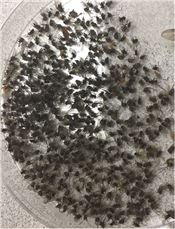Arkansas River Valley Sees Rise In Bird Deaths Attributed To Black Fly Variants
RYAN MCGEENEY
FAYETTEVILLE, ARKANSAS
Amid concerns of rising avian flu cases, poultry flock managers in Arkansas’ River Valley region are reporting multiple cases of bird deaths attributed to another familiar culprit: The turkey gnat.
Dustan Clark, extension veterinarian and associate director of the Poultry Center for the University of Arkansas System Division of Agriculture, said tiny, blood-sucking black fly within the Simuliidae insect family include variants such as the turkey gnat and the buffalo gnat.
“The potential for an outbreak in areas of Arkansas is possible as large amounts of rain have fallen this spring and we are now experiencing cooler temperatures,” Clark said. “Several owners of small poultry flocks in Arkansas have lost birds due to attacks” from turkey gnats.
“In some flocks, all birds were lost due to the gnats,” he said.
Both turkey and buffalo gnats “need moving water for their lifecycle,” Clark said. “With all this rain, we’re experiencing a bunch more cases.”
Tiny differences
Kelly Loftin, extension entomologist for the Division of Agriculture, said Buffalo gnats are often conflated with turkey gnats.
“They’re similar in most ways, but they differ in their timing,” he said. “Buffalo gnats typically come out a bit earlier, around Easter most years, because they’re more sensitive to heat than the turkey gnats, which come out one to two months later.”
While buffalo gnat populations tend to die off when temperatures rise into the 80s, turkey gnat populations tend to tolerate the heat into the 90s.
Loftin said the cases of flock death attributable to the black flies he has seen this year have occurred within the Arkansas River Valley, from Van Buren to Ozark to Conway.
On the alert
While the numbers of gnat-attributed deaths in turkey, chicken and other bird flocks aren’t necessarily likely to reach epic proportions, they are being confirmed more quickly than usual because of concern over avian flu, Clark said.
“Every time there’s a sudden die-off of a flock, the state investigates for the possibility of avian flu,” he said. “Last Friday, we saw two cases that were negative for avian flu, positive for gnats.”
Arkansas State Veterinarian John Nilz said the cases involved dozens of birds apiece.
A history of biting
Struggles with these insects aren’t limited to the western half of the state, however. In 2018, producers in Arkansas County reported the deaths of almost 100 livestock animals attributed to buffalo gnats in April; hunters and wildlife officials in the area reported the fly- related deaths of more than 280 deer in the area during the same period. It was the most significant recorded outbreak in the state since 1934, when buffalo gnats killed more than 1,000 mules in the area.
Loftin said that the most common cause of death related to gnat swarms is toxemia or anaphylactic shock, in which the animal has an overwhelming allergic reaction to the gnats’ saliva. Occasionally, animals may die from blood loss due to the bites or from suffocation when large numbers of insects clog an animal’s airway.
In moving water, female black flies attach as many as 800 eggs to submerged rocks, plants or other objects. In 70-degree water, the eggs will hatch in four to five days.
“The entire life cycle takes about four to six weeks, depending on the species of black fly, temperature, available food and water temperature,” Clark said. “It is possible for several generations to be produced each year. Fortunately, the adults only live two to three weeks.”
Treatment options
Clark said that some producers have experienced successful flock protection by applying compounds containing citronella oil to the birds, hanging fly strips or aluminum pie plates in sunlight.
Another effective abatement approach is the application of Bacillus thuringiensis var. israelensis, commonly known as Bti, which is often used to repress a variety of nuisance insects.
Clark cautioned that producers protect their own health as well.
“If you have to be outside when the gnats are active, wear long- sleeved, bright-colored clothing – but do not wear light blue,” he said. “Head and shoulder nets can also be worn. Insect repellants that contain DEET may also be helpful. Clothing can also be treated with fly repellents.”
If someone has an allergic reaction to a buffalo gnat bite, he or she should seek prompt medical attention, Clark said.
He noted that, fortunately, black flies enjoy a relatively short window of activity.
For additional information on buffalo gnats, poultry diseases, care or husbandry, contact your local county extension agent, the Arkansas Cooperative Extension service (www.uaex.edu) or contact Clark directly at fdclark@uark.edu or 479-957-4245.
“With the current outbreak of avian influenza, it is important that if you see something in your flock that is unusual or have bird losses, get help immediately,” Clark said. Producers should contact their local veterinarian, local county extension agent, extension poultry veterinarian, state veterinarian, or call the U.S. Department of Agriculture hotline at 1-866-536-7593. ∆
RYAN MCGEENEY: University of Arkansas

Several poultry flock deaths throughout the Arkansas River Valley have been attributed to black fly swarms. Shown here is a population of adult buffalo gnats, a variant of the black fly. Turkey gnats, another variant, are also common under certain conditions.
Image courtesy Kelly Loftin